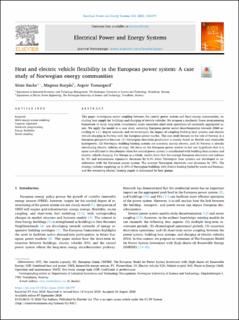| dc.contributor.author | Backe, Stian | |
| dc.contributor.author | Tomasgard, Asgeir | |
| dc.contributor.author | Korpås, Magnus | |
| dc.date.accessioned | 2021-03-12T08:10:24Z | |
| dc.date.available | 2021-03-12T08:10:24Z | |
| dc.date.created | 2020-09-10T11:30:26Z | |
| dc.date.issued | 2020 | |
| dc.identifier.issn | 0142-0615 | |
| dc.identifier.uri | https://hdl.handle.net/11250/2733038 | |
| dc.description.abstract | This paper investigates sector coupling between the central power system and local energy communities, including heat supply for buildings and charging of electric vehicles. We propose a stochastic linear programming framework to study long-term investments under uncertain short-term operations of nationally aggregated assets. We apply the model to a case study assuming European power sector decarbonization towards 2060 according to a 1.5 degree scenario, and we investigate the impact of coupling building heat systems and electric vehicle charging in Norway with the European power market. The case study focuses on the role of Norway in a European perspective because: (1) Norwegian electricity production is mainly based on flexible and renewable hydropower, (2) Norwegian building heating systems are currently mainly electric, and (3) Norway is already introducing electric vehicles at large. We focus on the European power market to test our hypothesis that it is more cost-efficient to decarbonize when the central power system is coordinated with building heat systems and electric vehicle charging. For Europe as a whole, results show that the average European electricity cost reduces by 3% and transmission expansion decreases by 0.4% when Norwegian heat systems are developed in coordination with the European power system. The average Norwegian electricity cost decreases by 19%. The strategy includes supplying up to 20% of Norwegian buildings with district heating fueled by waste and biomass, and the remaining electric heating supply is dominated by heat pumps. | en_US |
| dc.language.iso | eng | en_US |
| dc.publisher | Elsevier | en_US |
| dc.rights | Navngivelse 4.0 Internasjonal | * |
| dc.rights.uri | http://creativecommons.org/licenses/by/4.0/deed.no | * |
| dc.title | Heat and electric vehicle flexibility in the European power system: A case study of Norwegian energy communities | en_US |
| dc.type | Peer reviewed | en_US |
| dc.type | Journal article | en_US |
| dc.description.version | publishedVersion | en_US |
| dc.source.volume | 125 | en_US |
| dc.source.journal | International Journal of Electrical Power & Energy Systems | en_US |
| dc.identifier.doi | https://doi.org/10.1016/j.ijepes.2020.106479 | |
| dc.identifier.cristin | 1828677 | |
| dc.relation.project | Norges forskningsråd: 257660 | en_US |
| cristin.ispublished | true | |
| cristin.fulltext | postprint | |
| cristin.fulltext | original | |
| cristin.qualitycode | 1 | |

